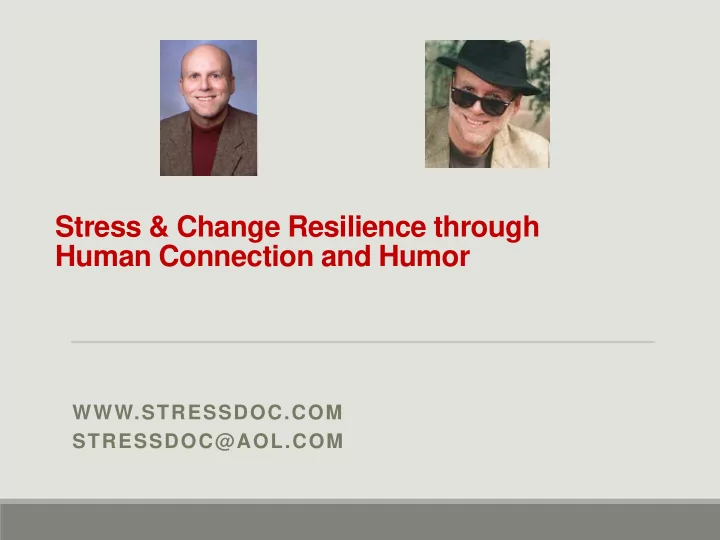

Stress & Change Resilience through Human Connection and Humor WWW.STRESSDOC.COM STRESSDOC@AOL.COM
Program Objectives 1. Rapidly, purposefully and playfully recognize stress smoke signals, burnout stages, and “R”s of prevention & recovery 2. Grapple with the varying challenges of “letting go,” listening, and connecting 3. Disarm self-defeating power struggles; build trust through affirming "I" messages and courageous “good” questions 4. Engage in Feeling Underutilized Exercise 5. Confront Intimate FOE and “Top Ten” Stress Resilience Tips for Trauma, Transition & Everyday Stress 2
Burnout: Organizational and Individual Perspectives 1. The Triple “A”: Authority, Autonomy & Accountability 2. Bjorn Bored Syndrome 3. Remember, burnout is less a sign of failure and more that you gave yourself away! 3
Four Stages of Burnout 1. Physical, Mental & Emotional Exhaustion 2. Shame and Doubt 3. Cynicism & Callousness 4. Failure, Helplessness & Crisis 4
The Heart of “Letting Go” Good Grief: loss of control, dreams, ghosts, mind-body mobility, health, (toxic) relations, and environs Existential Loss: your own world or way of being; threat or challenge to security, identity, and meaning Disarming Power Struggles: kitchen confrontation Egoal and Esteem Issues Self-Defeating Habits Entitlement or “Loyalty Lock” Family & Organizational Myths & Secrets Intimate FOE to Courageous Flow: couch conversation An Inspiring Example: “Father Knows Best” (Sometimes ) Story 5
VITAL LESSON OF THE FOUR “R”s If no matter what you do or how hard you try, Results, Rewards, Recognition and Relief are not forthcoming and you can’t say “No” or won’t “let go”…trouble awaits. The groundwork is being laid for apathy, callousness and despair. 6
Barriers to Communication and Connection Exercise 1. Identify obstacles to communication and connection (C & C) 2. How do cultural value differences impact “C & C”? 3. How does fear and loss, change, and letting go factor in? 4. What interventions have worked; where are the gaps? How might we explore new options? 5. Benefits and losses; “sadder yet wiser” 7
Eight “F”s of Loss and Change Loss of the Familiar Uncertain Future Loss of Face Rebuild Fire Reassert Focus Seek Feedback Have Faith And even FUN! 8
Active Listening & Questioning Skills: CPRS C = Clarify & Be Concise (The New KISS) P = Paraphrase & Pause R = Reaction & Response, Reflect & Reveal S = Strategize & Summarize 9
Four “C”s of Psychological Hardiness: A Research Perspective Commitment – workable work-life dynamic Control – realistic and “letting go” Change – inevitable and flexible Conditioning – regular exercise 10
The Mystery of Grief Renewal Whether the loss is a key person, a desired position or a powerful illusion, each deserves the respect of a mourning. The pit in the stomach, the clenched fists and quivering jaw, the anguished sobs prove catalytic in time. In mystical fashion, like spring upon winter, the seeds of dissolution bear fruitful renewal. 11
Six “C” s of Power Struggles Control Competition Change Cultural Diversity/Competency Communication Skills Courage 12
Communication Strategies Six “C”s of Power Struggles Drop the Rope Use the Four Empathic “P”s Reduce the Status Differential Be Vital and Vulnerable Avoid All or None Thinking “I” vs. “You” Messaging Ask Good Questions…Formula for Respect 13
Confronting Your Intimate FOE From Fear of Exposure to Fun of Embarrassment 1. From Cultural Diversity to Mutual Humanity 2. Misery, Mastery, Mirth & Memory Connection 3. Distinguishing Neurotic Humiliation from Natural Embarrassment 4. Putting on Life Jacket & Protective Ves t
“Top Ten” Tips for Surviving Trauma, Transition & Everyday Stress 1. Find a “Stress Buddy” 2. Speak to a Professional 3. Join a Support Group 4. Understand Change, Loss, and the Need to Grieve 5. Value Sleeping/Rejuvenating and Healthy Eating 6. Exercise Regularly and/or Mindfully 7. Learn to Say “No” and Set Limits 8. Identify and Defuse Stress Triggers 9. Get Organized 10. Pursue a Hobby, Art, and Laughter 15
Natural SPEED • • S = Sleep • P = Priorities/Passion • E = Empathy • E = Exercise/Exorcise • D = Diet 16
Diet Changes to Improve Mind/Mood • Omega 3 Fish: salmon, sardines, tuna; neural transmission; depression fighting serotonin • Anti-Oxidant Fruits: berries, cherries, the “purples” • Leafy Green & Cruciferous Veggies: spinach, broccoli, cauliflower, kale, cabbage, avocado • Banana Smoothie: stimulates dopamine; natural pleasure drink • Nuts: walnuts, almonds, pistachios, raw cashews; sunflower seeds – calming chemical selenium • Celery Stick and Almond Butter: helps lower blood pressure; Vitamin K 17
Recommend
More recommend